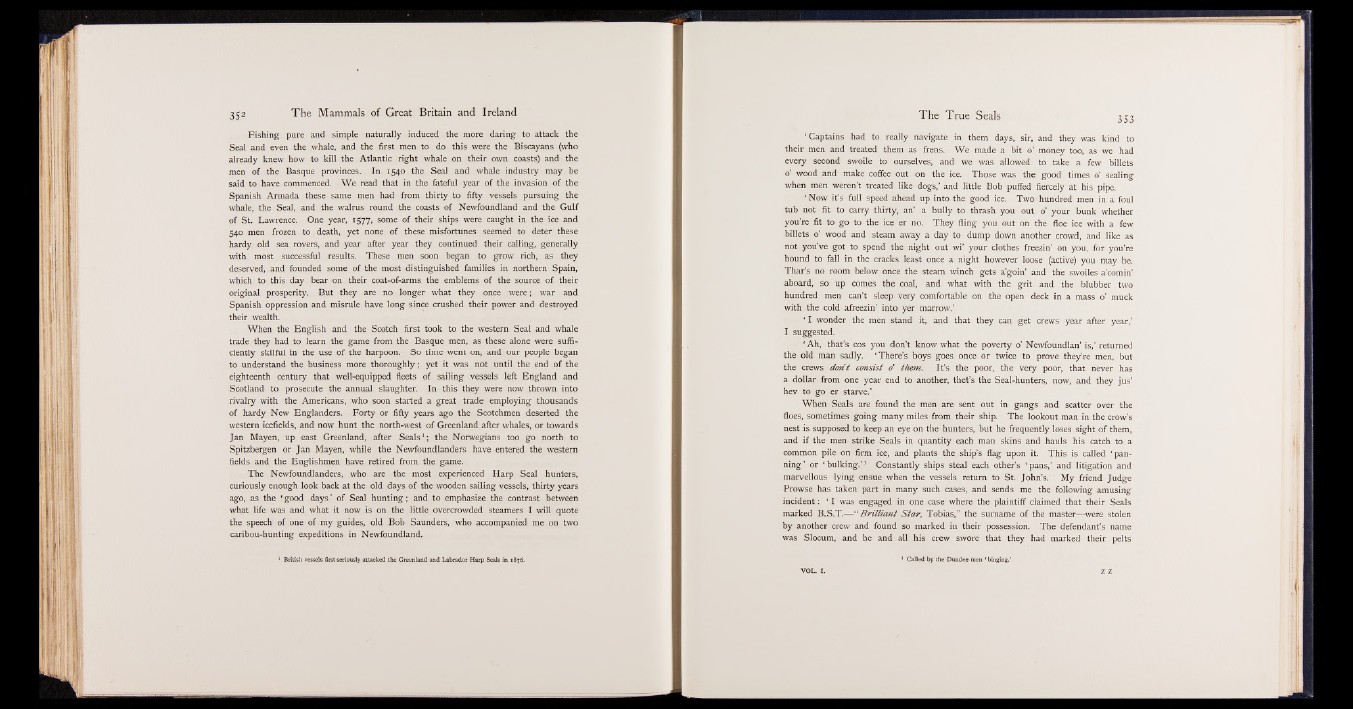
Fishing pure and simple naturally induced the more daring to attack the
Seal and even the whale, and the first men to do this were the Biscayans (who
already knew how to kill the Atlantic right whale on their own coasts) and the
men of the Basque provinces. In 1540 the Seal and whale industry may be
said to have commenced. We read that in the fateful year of the invasion of the
Spanish Armada these same men had from thirty to fifty vessels pursuing the
whale, the Seal, and the walrus round the coasts of Newfoundland and the Gulf
of St. Lawrence. One year, 1577, some of their ships were caught in the ice and
540 men frozen to death, yet none of these misfortunes seemed to deter these
hardy old sea rovers, and year after year they continued their calling, generally
with most successful results. These men soon began to grow rich, as they
deserved, and founded some of the most distinguished families in northern Spain,
which to this day bear on their coat-of-arms the emblems of the source of their
original prosperity. But they are no longer what they once were; war and
Spanish oppression and misrule have long since crushed their power and destroyed
their wealth.
When the English and the Scotch first took to the western Seal and whale
trade they had to learn the game from the Basque men, as these alone were sufficiently
skilful in the use of the harpoon. So time went on, and our people began
to understand the business more thoroughly; yet it was not until the end of the
eighteenth century that well-equipped fleets of sailing vessels left England and
Scotland to prosecute the annual slaughter. In this they were now thrown into
rivalry with the Americans, who soon started a great trade employing thousands
of hardy New Englanders. Forty or fifty years ago the Scotchmen deserted the
western icefields, and now hunt the north-west of Greenland after whales, or towards
Jan Mayen, up east Greenland, after Seals1; the Norwegians too go north to
Spitzbergen or Jan Mayen, while the Newfoundlanders have entered the western
fields and the Englishmen have retired from the game.
The Newfoundlanders, who are the most experienced Harp Seal hunters,
curiously enough look back at the old days of the wooden sailing vessels, thirty years
ago, as the ‘ good days ’ of Seal hunting; and to emphasize the contrast between
what life was and what it now is on the little overcrowded steamers I will quote
the speech of one of my guides, old Bob Saunders, who accompanied me on two
caribou-hunting expeditions in Newfoundland.
1 British vessels first seriously attacked the Greenland and Labrador Harp Seals in 1876.
‘ Captains had to really navigate in them days, sir, and they was kind to
their men and treated them as frens. We made a bit o’ money too, as we had
every second swoile to ourselves, and we was allowed to take a few billets
0’ wood and make coffee out on the ice. Those was the good times o’ sealing
when men weren’t treated like dogs,’ and little Bob puffed fiercely at his pipe.
‘ Now it’s full speed ahead up into the good ice. Two hundred men in a foul
tub not fit to carry thirty, an’ a bully to thrash you out 0’ your bunk whether
you’re fit to go to the ice er no. They fling you out on the floe ice with a few
billets 0’ wood and steam away a day to dump down another crowd, and like as
not you’ve got to spend the night out wi’ your clothes freezin’ on you, for you’re
bound to fall in the cracks least once a night however loose (active) you may be.
Thar’s no room below once the steam winch gets a’goin’ and the swoiles a’comin’
aboard, so up comes the coal, and what with the grit and the blubber two
hundred men can’t sleep very comfortable on the open deck in a mass o’ muck
with the cold afreezin’ into yer marrow.’
‘ I wonder the men stand it, and that they can get crews year after year,’
I suggested.
‘ Ah, that’s cos you don’t know what the poverty 0’ Newfoundlan’ is,’ returned
the old man sadly. ‘ There’s boys goes once or twice to prove they’re men, but
the crews don't consist o' them. It’s the poor, the very poor, that never has
a dollar from one year end to another, thet’s the Seal-hunters, now, and they jus’
hev to go er starve.’
When Seals are found the men are sent out in gangs and scatter over the
floes, sometimes going many miles from their ship. The lookout man in the crow’s
nest is supposed to keep an eye on the hunters, but he frequently loses sight of them,
and if the men strike Seals in quantity each man skins and hauls his catch to a
common pile on firm ice, and plants the ship’s flag upon it. This is called ‘ panning’
or ‘ bulking.’ 1 Constantly ships steal each other’s ‘ pans,’ and litigation and
marvellous lying ensue when the vessels return to St. John’s. My friend Judge
Prowse has taken part in many such cases, and sends me the following amusing
incident: 11 was engaged in one case where the plaintiff claimed that their Seals
marked B.S.T.— “ B rilliant Star; Tobias,” the surname of the master— were stolen
by another crew and found so marked in their possession. The defendant’s name
was Slocum, and he and all his crew swore that they had marked their pelts
1 Called by the Dundee men ‘ binging.’
VOL. iv Z Z